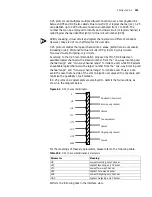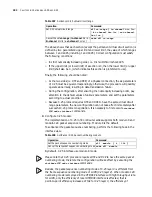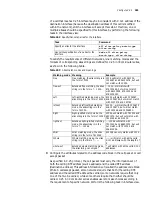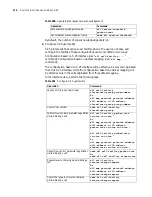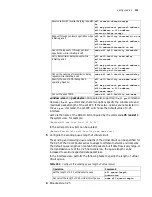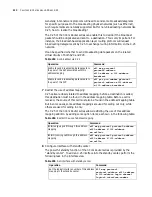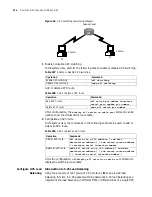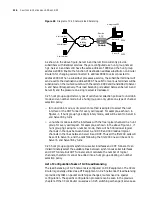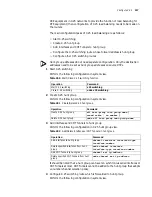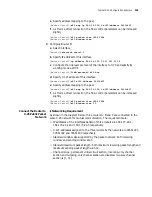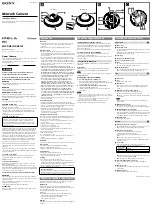
Configure X.25
215
which guarantees no occurrence of link overload when an address is accessed by a
large number of subscribers.
X.25 load balancing is provided by DCEs. In order to implement the load balancing
in X.25 networks, a group of DTE/DCE interfaces (synchronous serial interfaces or
XOT Tunnels) need to be configured at the remote DCE on the network as a hunt
group. And it is necessary to allocate an X.121 address to such hunt group. When
other equipment in the network accesses the DTE inside the hunt group, they
need to call the hunt group address. After receiving the call request packets, the
remote DCE will, according to diverse channel selection policies (round-robin or
vc-number), select a line in the hunt group and send the incoming call packets.
Different calls will be allocated to the lines in the hunt group, thus achieving load
balancing.
It should be noted that X.25 hunt group can dynamically select different
transmission lines only in the process of the establishment of virtual circuit call.
Once the whole virtual circuit is established and enters into the stage of data
transmission, hunt group will be ineffective and data transmission will be
processed in accordance with the normal virtual circuit. After being established,
PVC stays at the data transmission stage without the process of call establishment
and call deletion, therefore X.25 load balancing is ineffective on PVC and
functions only on SVC.
Within a single X.25 hunt group, all DTEs hold identical status and have the same
X.121 addresses. The DTEs in a hunt group can call other DTEs outside the hunt
group in a normal mode. When equipment outside the hunt group access the
hunt group, they cannot know which equipment they will access, because the line
selection is controlled by the DCEs configured with hunt group.
DTE addresses in a hunt group may be identical or different to the hunt group
addresses. X.25 hunt group supports the substitutions of source address and
destination address. The function of destination address substitution enables us to
hide the addresses of DTEs inside the hunt group, thus external DTEs only know
the hunt group address, which enforces the security of the internal network of
hunt group. The function of source address substitution can hide the addresses of
DTEs outside a hunt group, therefore internal DTEs can only know the substituted
source address instead of the source address a call is connected to, which protects
subscribers' privacy.
Summary of Contents for 3036
Page 1: ...http www 3com com 3Com Router Configuration Guide Published March 2004 Part No 10014299 ...
Page 4: ...VPN 615 RELIABILITY 665 QOS 681 DIAL UP 721 ...
Page 6: ...2 ABOUT THIS GUIDE ...
Page 7: ...I GETTING STARTED Chapter 1 3Com Router Introduction Chapter 2 3Com Router User Interface ...
Page 8: ...4 ...
Page 16: ...12 CHAPTER 1 3COM ROUTER INTRODUCTION ...
Page 34: ...30 ...
Page 60: ...56 CHAPTER 3 SYSTEM MANAGEMENT ...
Page 98: ...94 CHAPTER 6 DISPLAY AND DEBUGGING TOOLS ...
Page 110: ...106 ...
Page 114: ...110 CHAPTER 8 INTERFACE CONFIGURATION OVERVIEW ...
Page 158: ...154 CHAPTER 10 CONFIGURING WAN INTERFACE ...
Page 168: ...164 ...
Page 188: ...184 CHAPTER 13 CONFIGURING PPPOE CLIENT ...
Page 192: ...188 CHAPTER 14 CONFIGURING SLIP Router ip route static 0 0 0 0 0 0 0 0 10 110 0 1 ...
Page 248: ...244 CHAPTER 16 CONFIGURING LAPB AND X 25 ...
Page 320: ...316 ...
Page 330: ...326 CHAPTER 20 CONFIGURING IP ADDRESS ...
Page 362: ...358 CHAPTER 21 CONFIGURING IP APPLICATION ...
Page 374: ...370 CHAPTER 23 CONFIGURING IP COUNT ...
Page 406: ...402 CHAPTER 25 CONFIGURING DLSW ...
Page 408: ...404 ...
Page 452: ...448 CHAPTER 29 CONFIGURING OSPF ...
Page 482: ...478 CHAPTER 30 CONFIGURING BGP ...
Page 494: ...490 CHAPTER 31 CONFIGURING IP ROUTING POLICY ...
Page 502: ...498 ...
Page 508: ...504 CHAPTER 33 IP MULTICAST ...
Page 514: ...510 CHAPTER 34 CONFIGURING IGMP ...
Page 526: ...522 CHAPTER 36 CONFIGURING PIM SM ...
Page 528: ...524 ...
Page 532: ...528 CHAPTER 37 CONFIGURING TERMINAL ACCESS SECURITY ...
Page 550: ...546 CHAPTER 38 CONFIGURING AAA AND RADIUS PROTOCOL ...
Page 590: ...586 CHAPTER 40 CONFIGURING IPSEC ...
Page 599: ...IX VPN Chapter 42 Configuring VPN Chapter 43 Configuring L2TP Chapter 44 Configuring GRE ...
Page 600: ...596 ...
Page 638: ...634 CHAPTER 43 CONFIGURING L2TP ...
Page 649: ...X RELIABILITY Chapter 45 Configuring a Standby Center Chapter 46 Configuring VRRP ...
Page 650: ...646 ...
Page 666: ...662 ...
Page 670: ...666 CHAPTER 47 QOS OVERVIEW ...
Page 700: ...696 CHAPTER 49 CONGESTION MANAGEMENT ...
Page 706: ...702 CHAPTER 50 CONGESTION AVOIDANCE ...
Page 707: ...XII DIAL UP Chapter 51 Configuring DCC Chapter 52 Configuring Modem ...
Page 708: ...704 ...
Page 762: ...758 CHAPTER 52 CONFIGURING MODEM ...

